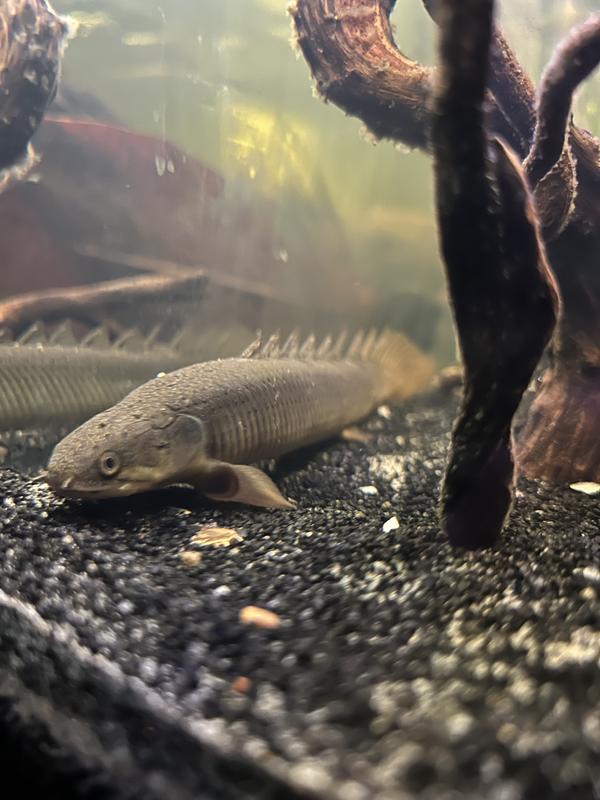The Dinosaur Fish, often known as Bichir (scientific name: Polypterus), is a prehistoric-looking species that fascinates many aquarium enthusiasts due to its ancient lineage, unique appearance, and resilient nature. Native to African freshwater habitats, Bichirs have evolved little over millions of years, earning them the nickname "dinosaur fish." This guide will cover everything you need to know about successfully caring for Dinosaur Fish, from habitat setup to feeding and breeding.

Dinosaur Fish, or Bichirs, belong to the genus Polypterus and are known for their elongated bodies, armored scales, and primitive lungs, which allow them to breathe air. These fish can grow to impressive lengths (typically 12 to 30 inches, depending on the species) and are carnivorous, feeding on small fish, insects, and crustaceans in the wild.
Dinosaur Fish require a large tank due to their active nature and considerable size.
Minimum tank size: At least 75 gallons for smaller Bichir species like the Senegal Bichir (Polypterus senegalus).
Larger species: Ornate Bichirs or Saddled Bichirs may need tanks of 100 gallons or more.
Ensure there is ample swimming space and hiding areas to mimic their natural habitat.
Maintaining stable water conditions is crucial for the health of Dinosaur Fish.
Temperature: 75–82°F (24–28°C)
pH level: 6.5 to 7.5 (neutral to slightly acidic)
Water hardness: 5-15 dGH
Filtration: A high-quality filter is essential to keep the water clean, as Dinosaur Fish produce a considerable amount of waste.
Water changes: Perform weekly water changes of 20-30% to maintain optimal water quality.
To create a comfortable environment for Dinosaur Fish:
Substrate: Soft sand or fine gravel to prevent injury to their sensitive underbellies.
Hiding spots: Add driftwood, rocks, and caves to provide shaded areas where the fish can rest.
Plants: Use hardy, rooted plants such as Anubias or Java Fern, as Bichirs tend to be indifferent to vegetation.
Bichirs are excellent escape artists. They have strong, flexible bodies and can climb or push their way out of the tank. Ensure the tank has a tight-fitting lid with no gaps.
In the wild, Dinosaur Fish are predators that consume live prey. In captivity, their diet should be protein-rich to replicate their natural nutrition.
Preferred foods:
Live or frozen foods: bloodworms, brine shrimp, krill, and small fish.
High-quality pellets designed for carnivorous fish.
Occasional treats: small pieces of shrimp, beef heart, or chopped earthworms.
Juveniles: Feed 2-3 times per day to support growth.
Adults: Feed once daily or every other day.
Remove uneaten food after 10-15 minutes to maintain water quality.
Dinosaur Fish are nocturnal hunters and may prefer feeding in low-light conditions. Dim the tank lights during feeding to encourage a more natural feeding behavior.
Dinosaur Fish are generally peaceful but can be predatory toward smaller fish that fit into their mouths. Choose tank mates that are similar in size and non-aggressive.
Suitable tank mates include:
Large catfish (e.g., Plecos)
Arowanas
Ropefish
Cichlids (non-aggressive varieties)
Avoid pairing Dinosaur Fish with:
Small species (e.g., Neon Tetras, Guppies), as they may be eaten.
Aggressive tank mates (e.g., overly territorial cichlids) that could attack the Dinosaur Fish.
Breeding Dinosaur Fish in captivity is challenging but possible with proper conditions.
Tank size: At least 100 gallons for a breeding pair.
Water conditions: Slightly acidic water (pH 6.5-7.0) and temperatures around 80°F (27°C) can encourage spawning.
Substrate: Provide soft sand and plenty of hiding spots.
The male Bichir will court the female by swimming close to her and displaying his fins.
After successful mating, the female lays adhesive eggs among plants or surfaces.
Once the eggs hatch (typically after 3-4 days), move the fry to a separate rearing tank to avoid predation.
Feed the fry with infusoria, baby brine shrimp, or powdered fry food.
Perform frequent but small water changes to maintain water quality without stressing the fry.
Symptoms: Loss of appetite, white spots, or erratic swimming.
Treatment: Use a parasite treatment suitable for freshwater fish, and quarantine affected fish to prevent the spread.
Symptoms: Fraying or discolored fins.
Cause: Poor water quality or injuries.
Solution: Improve water conditions and treat with antibacterial medications if needed.
Symptoms: Skin lesions, swelling, or lethargy.
Solution: Quarantine the affected fish and administer antibacterial treatments.
Regularly test water parameters.
Avoid overfeeding to reduce waste.
Quarantine new fish before introducing them to the main tank.
Perform weekly water changes (20-30%).
Clean the substrate to remove debris.
Monitor your Bichir’s behavior and appetite.
Look for signs of stress, illness, or unusual behavior.
Create a varied environment with caves and shaded areas.
Adjust lighting to simulate natural day-night cycles.
There are several species of Bichirs, each with its unique charm:
Size: Up to 12-14 inches.
Temperament: Peaceful.
Size: Up to 24 inches.
Distinctive feature: Beautifully patterned fins.
Size: Up to 30 inches.
Temperament: Predatory.
Dinosaur Fish (Bichirs) are captivating creatures that bring a prehistoric touch to any aquarium. Their care requires a large tank, stable water conditions, and a protein-rich diet. With the right environment and care routine, these resilient fish can live for 10-15 years or more in captivity. By following the guidelines provided in this article, you can ensure that your Dinosaur Fish thrive and continue to enchant anyone who sees them.
animal tags: Dinosaur Fish
We created this article in conjunction with AI technology, then made sure it was fact-checked and edited by a Animals Top editor.